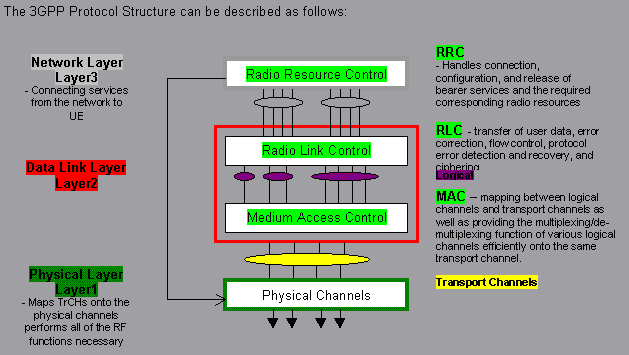W-CDMA Cellular-The Evolution
The basic and well-known multiple access techniques can be described as below:
D-AMPS, GSM, PDC (Japan), and iDEN are all flavors of the TDMA family of technologies.
In GSM, time slots are 0.5777msec. One time-slot transmits 156.25 bits. A time slot begins and ends with three tail bits which are always 0's. The guard band occupies 8.25 bits, and no transmission occurs to accommodate for RF rise and fall delays.
Two groups of 57 bits are used to transmit user information. The single bit adjacent to a group of information bits is used to designate whether control information is being sent, interrupting a speech or data channel. Lastly, 26 bits are used to keep the digital transmission in sync. Each mobile is assigned its own time slot.
Eight of these time slots comprise a frame and 26 frames comprise a multiframe, two frames are used for other purposes.
 GSM Traffic Channel
From source data to radio waves
Vocoder
Regular Pulse Excitation-Long Term Prediction
Channel Coding
Convolutional Encoder, rate ½, length 5
Interleaving
Performed by using 8 groups of 57 bits. (A speech block is spilt into 8 groups of 57bits. Each group is then carried in a separate burst)
Ciphering
Achieved by performing an "Exclusive OR" operation between a pseudo-random bit sequence and 114 useful bits of a normal burst.
Modulation
Uses GMSK (Gaussian Minimum Shift Keying)
Discontinuous Transmission (Optional feature)
A technique referred to LPC.RPE (Linear Predictive Encoding with Regular Pulse Excitation) is employed for voice digitization, at a rate of 13kbps. GSM has an optional mode of DTX (Discontinuous Transmission) where transmission is inhibited when no information is available for transmission.
The fundamental limits on communication over noisy channels are of concerned here. An error-free communication is possible on a noisy channel provided that the data rate is less than the channel capacity. Channel capacity depends on the bandwidth and the S/N ratio.
C = W log2 (1+ S/N), where C = Capacity (bps), W = Bandwidth (Hz), S = Signal Power, N = Noise Power
The 3GPP system is referred to the next generation replacement for PDC in Japan and for GSM in many parts of the world. The one unique feature of 3GPP W-CDMA is that it requires no special synchronization between cells. This unsynchronized nature makes placing base stations in underground subways, in tunnels and inside buildings much simpler.
The 3GPP network is designed to work with the following two networks:
3GPP W-CDMA has the following benefits:

The implementation of frequency resuse factor is important because of the following factors:
A receiver used in direct sequence spread spectrum signals. The receiver extracts energy in each path and then adds them together with appropriate weighting and delay.
The W-CDMA technology supports handoffs of the mobile from one cell to another while the mobile id on a traffic channel or in the idle state. The in-traffic transition from one cell to another can be either a Soft Handoff or a Hard Handoff. The transition from one cell to another while in the idle state has to be a hard handoff.
Soft handoff is a process of establishing a link with a target cell before breaking the link with a serving cell. In the W-CDMA system, the subscriber stations continuously search for Pilot channels on the current frequency. The downlink uses a Common Pilot Channel (CPICH) to send timing information to mobile stations. Mobile stations use the pilot data to maintain synchronization with the base station and as a coherent reference to perform synchronous demodulation.
The purpose of the continuous search is to detect potential candidates for handoff. When the mobile station detects a Pilot channel that is not associated with any of the Forward Traffic Channels currently demodulated, it will send a message to the serving cell. The soft handoff process can be described as follows:
The System Frame Number is multiplexed with the BCH transport channel and is carried over the air on the P-CCPCH.
|
___________________________________________________________________________________________________________________________________________________________________
About Lemonrain.com Contact Us Lemonrain Japan